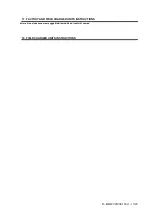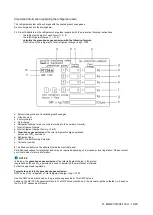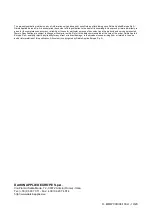
D-EIMWC01008-16EU - 9/20
0
2,17
19
4,14
39
7,25
58
12,16
77
18,81
1
2,25
20
4,27
40
7,46
59
12,46
78
19,23
2
2,33
21
4,41
41
7,66
60
12,76
79
19,65
3
2,41
22
4,55
42
7,87
61
13,07
80
20,07
8. INSTALLATION
8.1. Information about installation of
systems with R134a and R513A
Before machine installation and commissioning, the
people involved in this activity must have acquired the
information necessary to carry out these tasks, applying
all the information collected in this book
all the procedures
reported in the aforementioned norms and the provided
requirements by the local law.
Do not allow unauthorized and/or unskilled personnel to
access the unit.
8.2.
Additional guidelines for safe use
of R134a and R513A
Accordly to the standard EN 378-1-2016, any refrigerant
system that contains R134a or R513A, can be installed without
any restriction in open air or machinery rooms. Anyway, the
building owner or the end user shall ensure that that access is
permitted only by qualified and trained personnel, who is
aware of the general safety precautions of the building.
It is recommended to satisfy all the requirements listed in the
EN 378-3-2016 for the installation.
The refrigerant shall not be able to flow into any adjacent
room, doorway, or exhaust system in the event of a leak.
It is advised to install a refrigerant detection system which
works also during the normal operation of the refrigerant
system: in case of refrigerant leak indeed, it can activate the
alarm and all the necessary emergency procedures until the
machine shutoff.
The alarm shall also advice the authorized personnel to take
the necessary steps. The refrigerant leak detector shall be
supplied by the user, because it is a key component of the
sprinkler system of the entire building.
8.3. Physical characteristics of
refrigerant R1234ze (E)
This product can be equipped with refrigerant
R1234ze(E) which has minimal impact to the
environment, thanks to its low value of Global Warming
Potential (GWP).
Refrigerant type
R1234ze
Safety Class
A2L
PED Fluid Group
2
Pratical limit (kg/m3)
0.061
ATEL/ ODL (kg/m3)
0.28
LFL (kg/m3)@ 60°C
0.303
Vapour
density @25°C,
101.3 kPa (kg/m3)
4.66
Liquid
density
@25°C,
101.3 kPa (kg/m3)
Molecular Mass
114.0
Normal Boling Point (°C)
-19
GWP (100 yr ITH)
7
GWP (ARS 100 yr ITH)
<1
Auto Ignition Temperature
(°C)
368
8.4. Information about installation of
systems with R1234ze
The chillers are built in accordance with the main European
Directives (Machinery Directive, Low Voltage Directive,
Electromagnetic
Compatibility
Directive,
Pressurized
Equipment Directive), make sure you also receive the
declaration of product conformity with the directives along with
the documentation.
Before machine installation and commissioning, the
people involved in this activity must have acquired the
information necessary to carry out these tasks, applying
all the information collected in this book. Do not allow
unauthorized and/or unskilled personnel to access the
unit.
The chiller has to be installed in open air or machinery room
(location classification III).
To ensure location classification III a mechanical vent on the
secondary circuit(s) has to be installed.
Local building codes and safety standards shall be followed; in
absence of local codes and standards refer to EN 378-3:2016
as a guide. In paragraph
“Additional guidelines for safe use of
R1234ze
(E)” there are provided additional informations that
should be added to the requirements of safety standards and
building codes.
8.5. Additional guidelines for safe
use of R1234ze(E) for equipment
located in the open air
Refrigerating systems sited in the open air shall be
positioned to avoid leaked refrigerant flowing into a
building or otherwise endangering people and property.
The refrigerant shall not be able to flow into any
ventilation fresh air opening, doorway, trap door or
similar opening in the event of a leak. Where a shelter is
provided for refrigerating equipment sited in the open air
it shall have natural or forced ventilation.
For refrigeration systems installed outside in a location
where a release of refrigerant can stagnate e.g. below
ground, then the installation shall comply with the
requirements for gas detection and ventilation of
machinery rooms.
8.6. Additional guidelines for safe use
of R1234ze(E) for equipment
located in a machinery room
When a machinery room is chosen for the location of the
refrigerating equipment it shall be located in accordance
with local and national regulations. The following
requirements (according to EN 378-3:2016) can be used
for the assessment.
•
A risk analysis based on the safety concept for the
refrigerating system (as determined by the
manufacturer and including the charge and safety
classification of the refrigerant used) shall be
conducted to determine whether it is necessary to
place the refrigerating system in a separate
refrigeration machinery room.
•
Machinery rooms should not be used as occupied
spaces. The building owner or user shall ensure that
access is permitted only by qualified and trained
personnel doing the necessary maintenance to the
machinery room or general plant.
•
Machinery rooms shall not be used for storage with
the exception of tools, spare parts and compressor
oil for the installed equipment. Any refrigerants, or
flammable or toxic materials shall be stored as
required by national regulations.
•
Open (naked) flames shall not be permitted in
machinery rooms, except for welding, brazing or
Содержание EWWD J Series
Страница 20: ...D EIMWC01006 11EU 20 20 ...






































